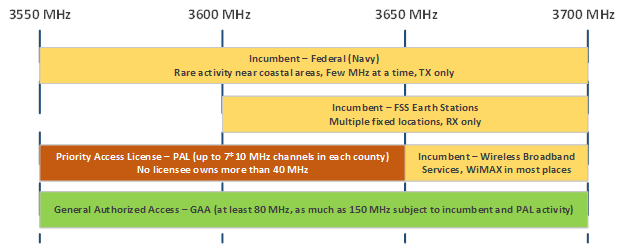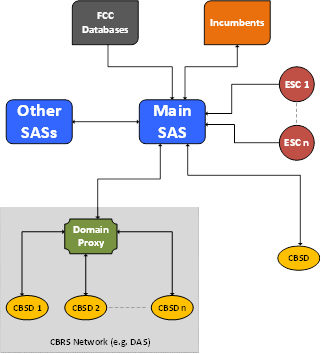September 5, 2019
Medium to large enterprises have long felt the need to have their own private wireless networks. The need arises from the following reasons:
- Lack of satisfaction with the quality of the carrier networks within their enterprise
- Having too many parallel networks for voice, data, IoT, public safety, etc.
- Inability to deploy locally controlled applications and services
- Necessity to move some applications to less secure and mobility-challenged Wi-Fi
- No avenues to generate revenue from wireless
The desire to have a private network, however, has never been fully realized due to one important factor: lack of spectrum ownership.
Enter CBRS. Access for enterprises to spectrum, turning private networks from dream to reality.
What is CBRS?
CBRS stands for Citizens Broadband Radio Service. Here are some important facts about CBRS:
- It is a “Band” not a technology (band 48). Any technology (e.g., LTE, 5G, or even non-3GPP technologies, in theory) can be used within this band as long as it adheres to the sharing stipulations
- The current CBRS spectrum is 3550 MHz – 3700 MHz
- The word “Citizen” in the CBRS signifies the importance of usage by the ordinary enterprises (i.e., it is not just for the carriers)
- It is a TDD (time division duplex) band which means it uses the same frequency band to transmit and receive
- Meant to spur innovation in connectivity and applications (much more so than Wi-Fi)

Figure 1 – “CBRS Alliance” OnGoTM brand for CBRS
- It is a “shared” band which means it is not totally dedicated as the carrier-purchased bands are, and it is not unlicensed as Wi-Fi bands where there is no active administration of the frequency bands. Remember “sharing is caring” so this band is intended to harmonize the usage between the registered parties while optimizing the usage of the precious spectrum resource. The “shared spectrum” concept is the first of its kind in the world to be implemented in such a vast scale. Any future expansion of this concept in U.S. and around the world relies on the success of this experiment (no pressure CBRS).
How it works
Much like any new band offered by FCC, there are already people using it in some form or fashion. Hence, CBRS has been architectured with a three-tier framework to accommodate the incumbents and open new possibilities for the new players as indicated below.

Figure 2 – Explanation of CBRS tiered architecture
Tier 1: The incumbents
The incumbents have the highest priority in the CBRS system and are protected from the users in the other tiers. The following incumbents use all or part of the CBRS band:
- Navy radars: radars on this bands are operational only on few ships and they would need protection when they visit the harbors. The bandwidth of radar channels is only few MHz
- Satellite earth stations: some but not all earth station and it is used in the 3600-3700 MHz chunk
- Wireless broadband service: for enterprise users only in the 3650-3700 MHz chunk primarily using WiMAX technology. These links are extensively used by likes of utilities, transportation giants, etc.
Tier 2: Priority Access License (PAL)
PAL licenses will be auctioned off in the middle of 2020. The PAL users have the second highest priority in the CBRS system and are protected from the GAA users. The following applies to PAL:
- Up to 70 MHz is leased as PAL within 3550 – 3650 MHz frequency range
- PAL licenses are leased per county
- Lease term is 10 years
- Each license is 10 MHz in bandwidth
- No one entity can lease more than 4 channel I each county (total of 40 MHz)
Tier 3: General Authorized Access (GAA)
GAA users need to register for a nominal administrative fee. The GAA users enjoy no protection from higher-tier users. The following applies to GAA:
- Up to 80 MHz is offered to GAA users within 3550 – 3700 MHz frequency range
- Until PAL is auctioned off, the entire 150 MHz is available to GAA
- Unpurchased and unused PAL spectrum will be offered to GAA
- GAA transmitting system need to bear the cost of a SAS
CBRS System Components
A CBRS system comprises the following elements:
- Spectrum Access Systems (SAS)
- Centrally coordinates access to the shared spectrum, enforcing priorities and modeling the RF environment
- Environmental Sensing Capability (ESC)
- Detects incumbent activity and informs SAS so that certain channels used by the incumbents can be cleared of lower priority use
- CBSD
- Radio nodes operating in the CBRS band, must coordinate with a SAS in order to transmit
- Domain Proxy
- CBSD aggregation and proxy functions for large networks; can be integrated with an EMS/NMS or be standalone
- End Device
- A user device such as a handset or an IoT element that uses the CBRS frequency band in connection with a CBSD

SAS (Spectrum Access System)
The “shared” nature of CBRS can only be enforced via a system administrator or a SAS. There are currently five certified SAS systems in U.S. – Federated, CommScope, Google, Sony, and Amdocs. Some of their functions are outlined below.
- SAS allows secure commercial use of 150 MHz shared spectrum
- Detect Incumbents using ESCs
- Dynamically allocates spectrum to users
- 80 MHz of spectrum always available for GAA
- Up to 70 MHz for PAL
- Unused PAL spectrum is used for GAA
- SAS will charge owners of CBSDs
- Predict RF propagation based on EHATA and ITM propagation models
- Provide interference protection by:
- Changing channels
- Temporarily discontinuing service
- It is typically cloud-based for scale
CBRS or Wi-Fi: Which one should I choose for my building?
Private LTE & CBRS OnGo Deployments by Connectivity Wireless
